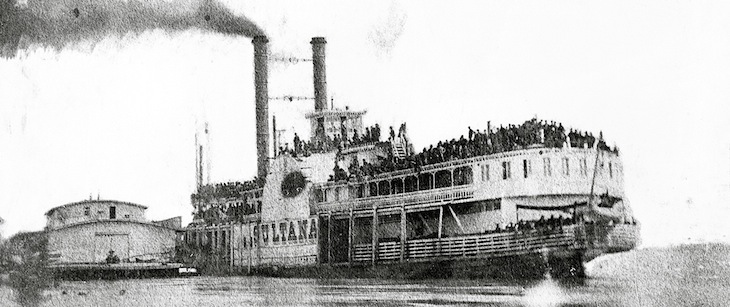Marion museum to chronicle worst maritime disaster in U.S. history
by June 11, 2018 9:53 am 2,843 views

On April 27, 1865, the steamboat Sultana exploded on the Mississippi River about 7 miles from Memphis.
Underneath a soybean field near Marion lies one of the most under-reported tragedies in the country’s history. On April 27, 1865, the steamboat Sultana exploded on the Mississippi River about 7 miles from Memphis. The boat carried more than 2,000 Union soldiers on their way home from the recently ended Civil War. At least 1,200 died. It’s considered the worst maritime disaster in U.S. history.
Sultana Disaster Museum Project Director Dr. Louis Intres told Talk Business & Politics it’s one of the most unknown events in American history. A nonprofit group, the Sultana Historic Preservation Society, is set to embark on an ambitious plan to build an interactive museum detailing the tragedy in Marion.
Museum plans are being formulated and it could cost as little as $4 million or as much as $10 million based on the size of the building, the technology used and the fundraising efforts, Intres said. The museum could be as large as 17,000 square feet, and preliminary plans call for it to be built in downtown Marion, he said.
“This isn’t an Arkansas story … this is an American story,” he said. “It has been forgotten. This is a story that must be told.”
A&P COMMISSION PLAN
The Marion A&P Commission has committed $845,000 toward the project during the next five years. When that’s added to the money the A&P has already spent, the total is more than $1 million, Intres said. SHPS will form a national fundraising committee, he said. Historians, those with corporate ties, foundations, philanthropic groups, those in the entertainment world, and others will be solicited, he said. It likely will be a five-year project.
The museum will have interactive features, he said. Younger visitors want an interactive experience, and the hope is to have holograms that tell the personal stories of those involved in the disaster, he said. The organization hopes to finalize plans in the coming months.
A feasibility study commissioned by the city of Marion estimates up to 40,000 visitors per year could be lured to the city. The report states $2.4 million in economic activity could be generated, adding $200,000 per year to the tax base. Tourists would spend $763,636 on hotel/lodging costs; $664,275 on food; $347,000 on retail; $318,525 on admissions/entertainment; $134,610 on fuel; and the rest will be spent on miscellaneous items.
SULTANA
The Sultana was a paddle-wheel steamboat commissioned in 1863 on the Mississippi River during the Civil War, according to historians. It had a maximum capacity of 376 passengers. The boat ultimately ended up in Vicksburg, Miss., at the war’s close. The chief quartermaster at Vicksburg, Lt. Reuben Hatch, had a military past filled with corruption. He was from Illinois and had a powerful ally who secured his position at Vicksburg — President Abraham Lincoln.
Hatch was facing a court-martial tribunal for taking bribes during a stint as the quartermaster in Cairo, Ill. His brother O.M. Hatch was a financial backer and personal friend of Lincoln, and before the court-martial took place, the sitting president sent the judge a letter that ultimately led to the dismissal of charges. Hatch then made his way south.
The Sultana arrived in Vicksburg on April 23, 1865, just days after the war had ended and Lincoln had been assassinated. Thousands of Union prisoners of war needed to be transported back to their homes. Many were sick and emaciated. Some were so weak they had to be carried onto the boat, Intres said.
Greed compelled Hatch to place more than 2,000 soldiers on the Sultana instead of dividing the soldiers between it and other available transport boats, said Intres. At Hatch’s behest, those efforts were refused. Loaded six times beyond its capacity wasn’t the only problem the Sultana faced. Her boilers were severely damaged and were in need of repair.
‘THOSE AWFUL SOUNDS’
Despite those factors, she began the churn north at 9 p.m. in the flood-swollen river headed for Cairo. Three boilers exploded late at night three days later. The hot coals, scalding water and fire killed hundreds in the moments following the initial blast.
Marion residents and other boats along the river attempted to save soldiers who were thrown into the chaotic waters. According to history.net, a sailor aboard the U.S.S. Tyler wrote in the ship’s log: “Of all the sounds and noises I ever heard that was the most sorrowful; some cursing, calling for help; and shrieking. I will never forget those awful sounds.”
For many years it was believed up to 1,800 soldiers were killed that night, making it a worse tragedy than the sinking of the Titanic in 1912. Recent research indicates the number is closer to 1,200, which means more were still killed on the Sultana than killed on the U.S.S. Arizona during the Dec. 7, 1941 attack on Pearl Harbor.
Why this tragedy is so unknown remains a mystery, Intres said. A combination of factors including Lincoln’s death, the killing of the president’s assassin, John Wilkes Booth, the day before the ship sank, the surrender of the last Confederate army, and the difficulty in getting news out of the South during that time all contributed, he said. One thing is certain, however.
“You can lay this tragedy on Abraham Lincoln’s desk,” he said.
